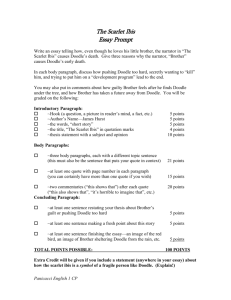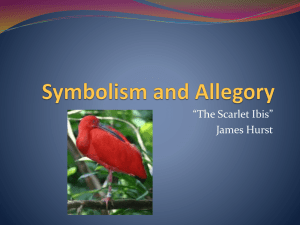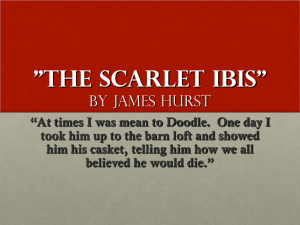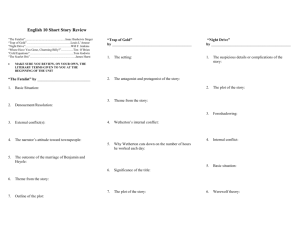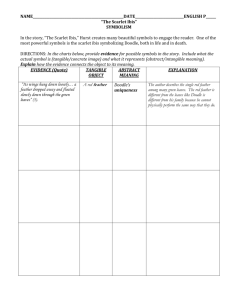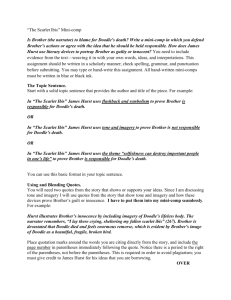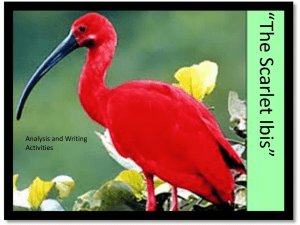The Scarlet Ibis - BernadetteStClair
advertisement
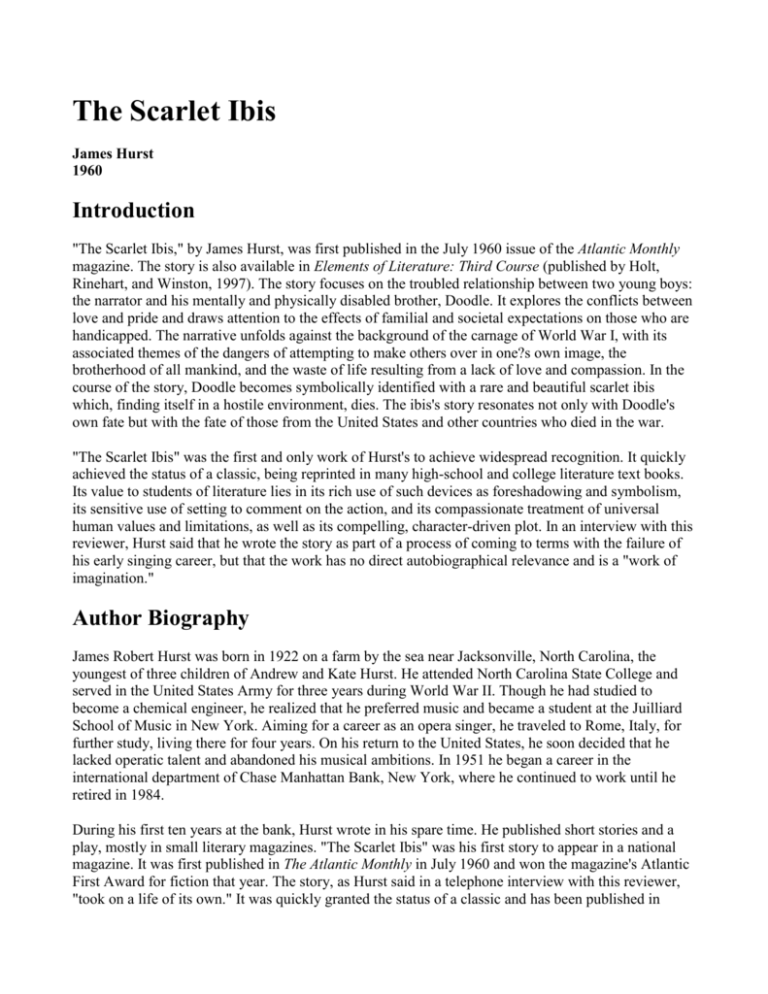
The Scarlet Ibis James Hurst 1960 Introduction "The Scarlet Ibis," by James Hurst, was first published in the July 1960 issue of the Atlantic Monthly magazine. The story is also available in Elements of Literature: Third Course (published by Holt, Rinehart, and Winston, 1997). The story focuses on the troubled relationship between two young boys: the narrator and his mentally and physically disabled brother, Doodle. It explores the conflicts between love and pride and draws attention to the effects of familial and societal expectations on those who are handicapped. The narrative unfolds against the background of the carnage of World War I, with its associated themes of the dangers of attempting to make others over in one?s own image, the brotherhood of all mankind, and the waste of life resulting from a lack of love and compassion. In the course of the story, Doodle becomes symbolically identified with a rare and beautiful scarlet ibis which, finding itself in a hostile environment, dies. The ibis's story resonates not only with Doodle's own fate but with the fate of those from the United States and other countries who died in the war. "The Scarlet Ibis" was the first and only work of Hurst's to achieve widespread recognition. It quickly achieved the status of a classic, being reprinted in many high-school and college literature text books. Its value to students of literature lies in its rich use of such devices as foreshadowing and symbolism, its sensitive use of setting to comment on the action, and its compassionate treatment of universal human values and limitations, as well as its compelling, character-driven plot. In an interview with this reviewer, Hurst said that he wrote the story as part of a process of coming to terms with the failure of his early singing career, but that the work has no direct autobiographical relevance and is a "work of imagination." Author Biography James Robert Hurst was born in 1922 on a farm by the sea near Jacksonville, North Carolina, the youngest of three children of Andrew and Kate Hurst. He attended North Carolina State College and served in the United States Army for three years during World War II. Though he had studied to become a chemical engineer, he realized that he preferred music and became a student at the Juilliard School of Music in New York. Aiming for a career as an opera singer, he traveled to Rome, Italy, for further study, living there for four years. On his return to the United States, he soon decided that he lacked operatic talent and abandoned his musical ambitions. In 1951 he began a career in the international department of Chase Manhattan Bank, New York, where he continued to work until he retired in 1984. During his first ten years at the bank, Hurst wrote in his spare time. He published short stories and a play, mostly in small literary magazines. "The Scarlet Ibis" was his first story to appear in a national magazine. It was first published in The Atlantic Monthly in July 1960 and won the magazine's Atlantic First Award for fiction that year. The story, as Hurst said in a telephone interview with this reviewer, "took on a life of its own." It was quickly granted the status of a classic and has been published in many high-school and college literature textbooks since the late 1960s. None of Hurst's other stories achieved similar recognition. Plot Summary "The Scarlet Ibis" opens with the narrator, Brother, reminiscing about a remarkable event that took place when he was a young boy at his family home at the end of the summer of 1918. A scarlet ibis, an exotic bird that does not belong in the narrator's region, landed in a tree in the family garden. This memory sparks off another in Brother's mind: the birth of his mentally and physically disabled brother, Doodle, when Brother was six years old. Nobody expected Doodle to live except Aunt Nicey, who delivered him. Doodle is a disappointment to everyone, particularly to Brother, who had wanted a brother who could run, jump, and race with him. A sobbing Mama believed he would never do these things and warned that he may not be mentally "'all there.'" Brother, appalled by the prospect of having a mentally retarded brother, plans to kill him. But one day, Doodle grins at Brother, and Brother decides that he is "'all there.'" By the time he is two, Doodle can only lie in bed or crawl backwards like a doodle-bug (hence Brother's choice of nickname, which sticks). Daddy builds a go-cart for him, and Doodle and the rest of the family press Brother into pulling him along with him everywhere he goes. Brother takes Doodle to Old Woman Swamp, where they pick flowers and make garlands for themselves. Doodle cries at the beauty of the place. However, Brother is sometimes cruel to Doodle. He shows him the coffin that Daddy ordered after Doodle's birth and stored in the barn loft and makes him touch it, threatening to leave him there if he does not. Doodle calmly declares that the coffin is not his but reacts with terror to the threat of being left alone, crying, "'Don't leave me.'" When Doodle is five, Brother feels embarrassed at having a brother who cannot walk and decides to teach him in secret. Doodle believes that he cannot walk and, indeed, does not see the need to. But Brother takes Doodle to Old Woman Swamp and laboriously works with him until he succeeds in learning to walk. On Doodle's sixth birthday, the boys reveal Doodle's new ability to the family. They all delightedly embrace Doodle, and when Doodle tells them that Brother taught him, they hug Brother too. Brother cries with unspoken shame, in the knowledge that his real motive was not love, but pride. Doodle's go-cart joins the coffin in the loft. Not content with his success in teaching Doodle to walk, Brother begins to teach him to run, swim, climb trees, and fight. In May and June 1918, the cotton and corn crops fail due to drought and a hurricane. People begin to talk of places in France where their men have been killed in the war. Brother worries that school will be starting soon and that Doodle is not ready. He pushes him harder. Doodle begins to decline in health, but Brother ignores the warning signs. One day, the family is eating lunch when a strange croaking noise is heard in the garden. Doodle is the first outside to investigate; the rest of the family follows. They find a large red bird sitting in the bleeding tree. It flutters and falls from the tree, landing dead at their feet. Daddy identifies it as a scarlet ibis, a native of the tropics. He believes a storm must have blown it off course. Doodle wants to bury the bird, but Mama forbids him to touch it as it may carry disease. While the rest of the family goes back inside to continue eating, Doodle finds a way to bury the bird without directly touching it. When he comes back into the house, he looks pale and says he is not hungry. After lunch, Brother takes Doodle to Horse-head Landing to continue his rowing lessons. Storm clouds gather. Doodle is tired and frightened. When he gets out of the boat, he collapses in the mud. He has failed and both boys know it. They start for home, with Brother walking faster and faster to try to outpace the storm. A tree is shattered by a bolt of lightning. Doodle, who has fallen behind, cries out, "'Brother, Brother, don't leave me! Don't leave me!'" Brother, feeling bitter at Doodle's failure, cruelly runs as fast as he can until he can no longer hear Doodle's voice. Finally, Brother grows tired and waits for Doodle, but he does not appear. Brother goes back and finds Doodle dead. He has been bleeding from the mouth, and his neck and the front of his shirt are red with blood. The position of his body is reminiscent of that of the scarlet ibis. Brother recognizes the link between the ibis's fate and Doodle's. He weeps, sheltering Doodle's body from the rain with his own. Characters Brother Brother is the lead protagonist of the story and also the narrator. He is not given a name but is referred to by Doodle, his brother, only as "Brother." He is six years old when Doodle is born. Brother has a high opinion of his own ability to run, jump, and climb, and wants a brother with whom he can share these activities. When it becomes clear that Doodle is capable of little more than lying on a rubber sheet and crawling backwards, Brother grows ashamed of Doodle's limitations and regularly taunts him. Though Brother loves Doodle, the love is tainted with cruelty and embarrassment. At the urging of Doodle and his parents, Brother reluctantly allows Doodle to accompany him on all his expeditions, pulling him along in his go-cart. Driven by shame at having a crippled sibling, Brother forms a plan to secretly teach Doodle to walk. Eventually, he succeeds. This initial success is not, however, enough for Brother, who is determined that Doodle will not shame him by being seen as different when he starts school. Brother pushes Doodle to do more and more strenuous activities until one day, he breaks into a run, leaving Doodle trailing. Doodle overstrains himself trying to keep up and dies of a heart attack. Brother weeps over his fallen brother and recognizes the symbolic link between Doodle and the beautiful and rare scarlet ibis that had fallen dead from a tree in the family garden earlier that day. Daddy Daddy, the father of Brother's family, has a coffin built for Doodle soon after his birth, in the belief that he will die. When Doodle survives, Daddy builds a go-cart for Doodle so that Brother can pull him around. Doodle Doodle is the mentally and physically retarded younger brother of the narrator, Brother. His family initially calls him by his given name, William Armstrong, but Brother nicknames him Doodle (after a doodle-bug, because of his habit of crawling backwards) and the name sticks. From the first, Doodle is a disappointment to his family, especially to Brother, because Doodle can only lie on a rubber sheet and crawl backwards. Everyone expects Doodle to die, but he defies them all and survives, becoming a loving boy with a strong attachment to Brother. Doodle is pulled around in a go-cart by Brother until Brother teaches Doodle to walk. This achievement, however, seems more important to Brother than it does to Doodle. Doodle's real strengths lie not on the level of his physical prowess, but on a more subtle inward level, to which Brother seems blind at the time the action takes place. From the beginning of his life, Doodle defies death and refuses to recognize the coffin that Daddy builds for him as his own. He shows a sense of wonder and respect for the natural world, crying with wonder at the wild beauty of Old Woman Swamp. He is the first to notice the visiting ibis and honors the bird by giving it a careful burial while finding a way of respecting his mother's orders not to touch it. The fact that Doodle is the only member of the family to care for the scarlet ibis enough to bury it shows his compassionate heart and emphasizes a symbolic link between boy and bird. This symbolic link is confirmed when Doodle dies on the same day as the bird and in a way that mirrors its fate. Doodle's greatest fear is of being left behind by the impatient Brother on their expeditions together. When this happens one day, he dies of a heart attack while trying to keep up with Brother. Mama Mama, the mother in Brother's family, despairs of Doodle's future from the beginning. She tearfully predicts that Doodle will never run or climb with Brother and believes that he might not be mentally normal. When the scarlet ibis drops dead from the tree, Mama forbids Doodle to touch the bird in case it is diseased. Mama's attitude to Doodle is reflected in her attitude to the bird: in both cases, she fails to see the beautiful and miraculous and expresses only fear and anxiety. Aunt Nicey Aunt Nicey is aunt to Brother and Doodle. She delivers Doodle and is the only person who believes that he will live. She has a religious nature, giving thanks to God when Doodle shows everyone that he can walk. Because Doodle is born with a caul, traditionally believed to be "Jesus' nightgown," Aunt Nicey warns that he should be treated with special respect since he may turn out to be a saint. Though prompted by superstitious belief, the comment shows an appreciation of Doodle's spiritual qualities and foreshadows a suggested symbolic link between Doodle, the ibis, and Christ. Themes Conflict between Love and Pride "The Scarlet Ibis" explores the conflict between love and pride in Brother's relationship with his physically and mentally disabled brother, Doodle. Brother loves and appreciates Doodle, as can be seen in the incident when the brothers fantasize about living in Old Woman Swamp, when Brother is overwhelmed by the beauty of the images that Doodle conjures up. Love is accepting and compassionate in its nature. But Brother's love for Doodle is challenged by two very human failings: pride, and the cruelty that results from it. Brother feels embarrassed and ashamed of Doodle's limitations and obvious differences from other people. They threaten his sense of pride. He decides to make Doodle do all the things that other people do in spite of the fact that Doodle himself sees no need to conform. Teaching Doodle to walk is Brother's first success. When Brother's family congratulates him on his success, he cries with shame, because he knows that he acted not out of love but out of pride, "whose slave [he] was." Brother's pride again triumphs over love when he continues to push Doodle to harder physical feats in spite of Doodle's obviously declining health. In the end, Doodle's heart fails under the strain, a victim of Brother's insistence. Well might Brother reflect, "I did not know then that pride is a wonderful, terrible thing, a seed that bears two vines, life and death." In this case, the "life" aspect is the undoubted progress that Doodle makes under Brother's demanding tutelage, and the "death" aspect refers to the fate of the fragile boy. The Desire to Make over Others in One's Own Image All of the family, except Brother, accepts Doodle as he is. However, their acceptance is not portrayed as entirely positive, as it comes with a heavy dose of resignation and hopelessness about Doodle's prospects. Mama and Daddy are so convinced that he will die soon after birth that Daddy orders a coffin for him. When Doodle does not die, Daddy makes the go-cart, accepting that Doodle will never walk. The consignment of coffin and go-cart to the loft are signs of the progress that Doodle makes in being like his older brother. Brother's impatience with Doodle's limitations is as ambiguous as the rest of the family's acceptance of them. But Brother's attitude is the more dangerous because it forces change on a body that is not equipped to deal with it and on a mind that does not desire it. Brother's success in re-making Doodle in his own image is greeted as wonderful progress by everyone except Doodle. When Brother tells him that he must learn to walk, Doodle asks, "'Why?'" Neither does Doodle understand why he should struggle to avoid being different from everybody else at school. Because the story is told from the point of view of Brother and not Doodle, it is not clear how much Doodle's life is improved by his new skills. But it is certain that after the initial success of the walking project, Brother's attempts to push Doodle further are destructive to Doodle's health and eventually contribute to his death. Topics for Further Study In "The Scarlet Ibis," Hurst uses natural elements of the setting to comment on the action or the characters. These include plants, birds, insects, and weather phenomena. Make a list of some of these natural elements and write a paragraph on each, explaining how they comment on the action or the characters. Where appropriate, research the habits, habitat, behavior, appearance, symbolic value or other aspects of each natural element and use your findings to elucidate your answers. Research the lives of two disabled people: one who is alive today, and one from history (born at any time before 1920). Write an essay on the lives and achievements of each. Include in your composition the following: the problems they faced and how they responded; society's and their family's attitudes to, and treatment of, them; and how the life and achievements of each may have been affected if they had been born in the other's time period. Write a short story in which the main character has a disability, or imagine that you have a particular disability and write a "day-in-the-life" diary entry. If you have a disability in real life, choose a different disability for this exercise. Take into account in your story or diary entry how your disability will affect your feelings, actions, perceptions, relationships and choices. Research the history of eugenics from its scientific beginnings in the nineteenth century to the present day, considering aspects such as selective breeding, enforced sterilization, human genetic engineering, and the use of eugenics to justify genocide. Write a report giving some arguments that have been made for and against each of these aspects of eugenics. Bear in mind that different sectors of society, such as disabled people, scientists, doctors, the non-disabled population and governments may well have different views, so try to gather your arguments from a variety of sources to reflect the full range of opinion. In each section, give your own view based on what you have learned. Research the experiences of a person who participated in World War I. This could be a person in active military service, or a nurse, journalist, ambulance driver, etc. Imagining that you are that person, write a letter to your family at home telling them about some of your recent experiences and your reflections on them. Brother tells us several times that his efforts with Doodle are motivated by pride: he is ashamed of having a disabled brother. There is a suggested parallel here with the background theme of World War I (1914–18), and many readers see an implied critique of the war in the story of Doodle and Brother. Significant numbers of American troops were sent to fight in Europe in the summer of 1918, when "The Scarlet Ibis" is set. Anti-war movements, like those gaining ground in 1960 when the story was written, point out that wars fought against other nations necessarily involve attempts to make over other nations in the aggressor's image. Prerequisites to such attempts, say these movements, are pride and arrogance: the aggressor nation has a conviction that it is in some way better than the victim nation and has a right to re-make the victim nation in its own image. This is generally as destructive and pointless in the long term as Brother's attempts to remake Doodle. World War I, far from being the "war to end all wars," as was claimed at the time, was soon followed by World War II (1939–45). Though leaders claimed at the time that war was the only option, many modern scholars question this view. Hurst does not shy away from emphasizing that the war's main legacy in the United States was the deaths of many men, a fact that he drives home in his references to American war graves and deaths. People who are Different Both Doodle and the scarlet ibis stand out as different; indeed, they are unique in the environment in which they find themselves. "The Scarlet Ibis" dramatizes the ways in which people respond to those who are different or disabled. At one end of the spectrum, Doodle's family believes that any meaningful quality of life is impossible and expects the boy to die. At the other end, Brother is determined to re-make Doodle so that he conforms to the norm and no longer embarrasses Brother. Doodle fails to identify with either expectation, refusing to die or admit that the coffin made for him is his, and remaining oblivious to Brother's insistence that he should not be different from the other children at school. In a sense, Doodle floats above the expectations of others like the winged beings of his fantasies. But finally, he succumbs in the face of the pressure of Brother to try to become the same as everyone else. Brotherhood It is significant that the lead protagonist of the story is known only by his relationship to Doodle: "Brother." This detail alerts readers to the fact that brotherhood is a major theme. Brother's love for Doodle is bound up with cruelty and shame. Doodle, for his part, is strongly attached to, and reliant upon, Brother and his main fear is of being left alone by him. He is terrified at Brother's threat to leave him in the barn loft if he does not touch the coffin, and cries, "'Don't leave me.'" He echoes these words with greater intensity on the day he dies, as Brother, bitter at Doodle's failure to perform the physical feats he has set for him, runs ahead of him in the rain. This time, Doodle cries, "Brother, Brother, don't leave me! Don't leave me!" Brother does leave him, if only temporarily, and the result is Doodle's death. Because the story takes place against the background of World War I, Doodle's words and the theme of brotherhood suggest a wider resonance. Brotherhood among soldiers fighting in appalling conditions in mud-filled trenches was a frequent theme in war literature and even on war memorials. Loyalty to one's fellow soldiers was seen as vital; if a soldier was injured, the loyalty or betrayal of his colleagues could mean the difference between his living or dying. There are many stories of heroism involving men risking their own lives to save a fallen colleague and equally stories of horror involving wounded men being left to die. In a more universal sense, the carnage of the war brought home the need to embrace the ideal of the brotherhood of all mankind regardless of differences in nation of origin, race, or religion. Style Setting "The Scarlet Ibis" is set in and around Brother's family home in the American South. The story is laden with rich descriptions of the natural environment, in the family garden and the nearby countryside. Hurst never describes the setting for its own sake; it always comments on the action. For example, the description of the "blighted" summer, with the hurricane bringing down trees and ruining crops, is introduced immediately after Brother recounts his intensification of Doodle's learning program. These images of devastation emphasize the destructive effects of Brother's pushing Doodle beyond his limits. Moreover, the nearby Old Woman Swamp embodies nature's abundance and beauty. For Brother and Doodle, it seems to signify a world of infinite possibilities and the glory of life. Doodle cries with wonder when he first sees it, and the boys gather wild flowers and make garlands and crowns with which to bedeck themselves. The suggestion is that this is a place where they feel royal, beautiful, and wealthy (the flowers are referred to as "jewels"). Old Woman Swamp is also where Brother teaches Doodle to walk, which, in spite of its disastrous outcome, represents a widening of Doodle's horizons. Doodle fantasizes about living a blissful existence in Old Woman Swamp. Foreshadowing Hurst frequently uses foreshadowing to suggest an upcoming event. This technique creates suspense as the reader waits for the resolution of a certain narrative thread. The first paragraph is an example: "It was in the clove of seasons, when summer was dead but autumn had not yet been born." This image of death is reinforced by the reference to the "untenanted" oriole nest that rocks "like an empty cradle." Cradles usually contain babies, a sign of new life, but this one is empty, suggestive of a dead child. Next follows a reference to "the last graveyard flowers," which speak "the names of our dead," evoking the image of men who have died in the war. These images combine with other elements, like the doctor's warning about Doodle's weak heart, to foreshadow the death of Doodle. Symbolism The scarlet ibis is a carefully chosen symbol. To understand why, it helps to know a little about the bird. A native of the South American tropics, the scarlet ibis is vivid red. Its color derives from the shrimps that form the bulk of its diet; if there are no shrimps, it loses its color. It needs a particular habitat in order to thrive as it only feeds in shallow waters along the coast, in mud flats and lagoons. The scarlet ibis is an endangered species which has not bred successfully in its natural habitat since the 1960s. Reasons for this include development of coastal areas, water pollution, and depletion of food sources. Scarlet ibises are colonial nesters, meaning that they nest in large flocks; they rely on the presence of other birds of their own species. The ibis in "The Scarlet Ibis" is symbolically linked with Doodle from the beginning of the plot, as the memory of the ibis's arrival triggers in Brother's mind the memory of Doodle, and Doodle immediately feels a bond with the bird. Like the ibis, Doodle is a being alone, different, singled out, with no flock, out of his natural environment. Like the ibis, he does not thrive in the environment in which he finds himself: he is delicate, sickly, and fragile. But while the ibis's beauty is obvious to Doodle, Doodle's beauty of spirit is hidden inside an unattractive exterior; thus, the bird externalizes Doodle's inner nature. Doodle is associated with winged and divine beings, just as the bird is literally a winged creature. Both boy and bird are characterized by sacred imagery. It could be argued that both are symbolically linked with Christ. Narrative Technique The story is told as a first-person reminiscence by Brother, who looks back from some time in his maturity to events that took place in his childhood. Thus he is able to imbue the raw events with his reflections on the lessons he learned from them. For example, Brother as a boy would not be able to explain that the reason he cried after his family congratulated him for teaching Doodle to walk was his shame at having acted from pride, "whose slave [he] was." This is the reflective adult speaking. The narrative technique of reminiscence also enables Brother to foreshadow events before they are described in the narrative, as in "I did not know then that pride is a wonderful, terrible thing, a seed that bears two vines, life and death." This statement suggests that Brother will at some point realize this truth, apparently through some catastrophic event, as indeed happens. That readers only observe the other characters through Brother's eyes might suggest that their sympathies lie with him. However, many readers will sympathize more with Doodle because of the emotional honesty of the adult Brother. He has had time to reflect on events and he lays bare the less admirable aspects of his character and of his feelings for Doodle, showing us the "knot of cruelty borne by the stream of love." If Doodle has a harsh side to his character, it is not presented; he comes through as an innocent. The adult Brother remains closely in touch with the negative emotions that many children feel for their close relatives. Children tend to be more open than adults about having mixed emotions for those close to them. They will declare that they hate their mother, brother, or best friend, only to show minutes later the love and devotion that they also feel. Adults tend to suppress such negative emotions because they are more able to see the consequences of expressing them. The adult Brother, however, does not gloss over his negative feelings for Doodle, and this candor increases readers' sympathy for the younger boy, the target of those feelings.

